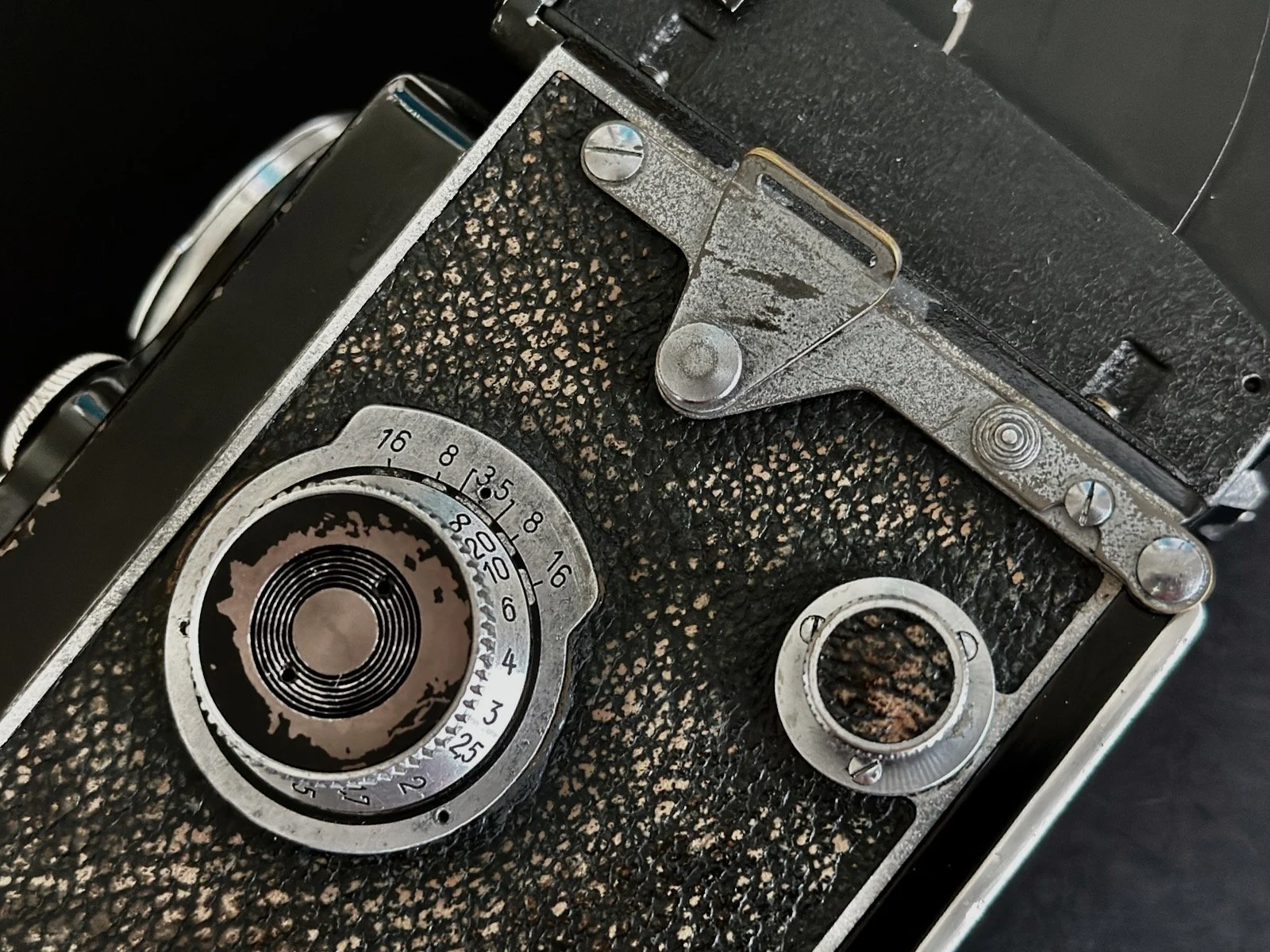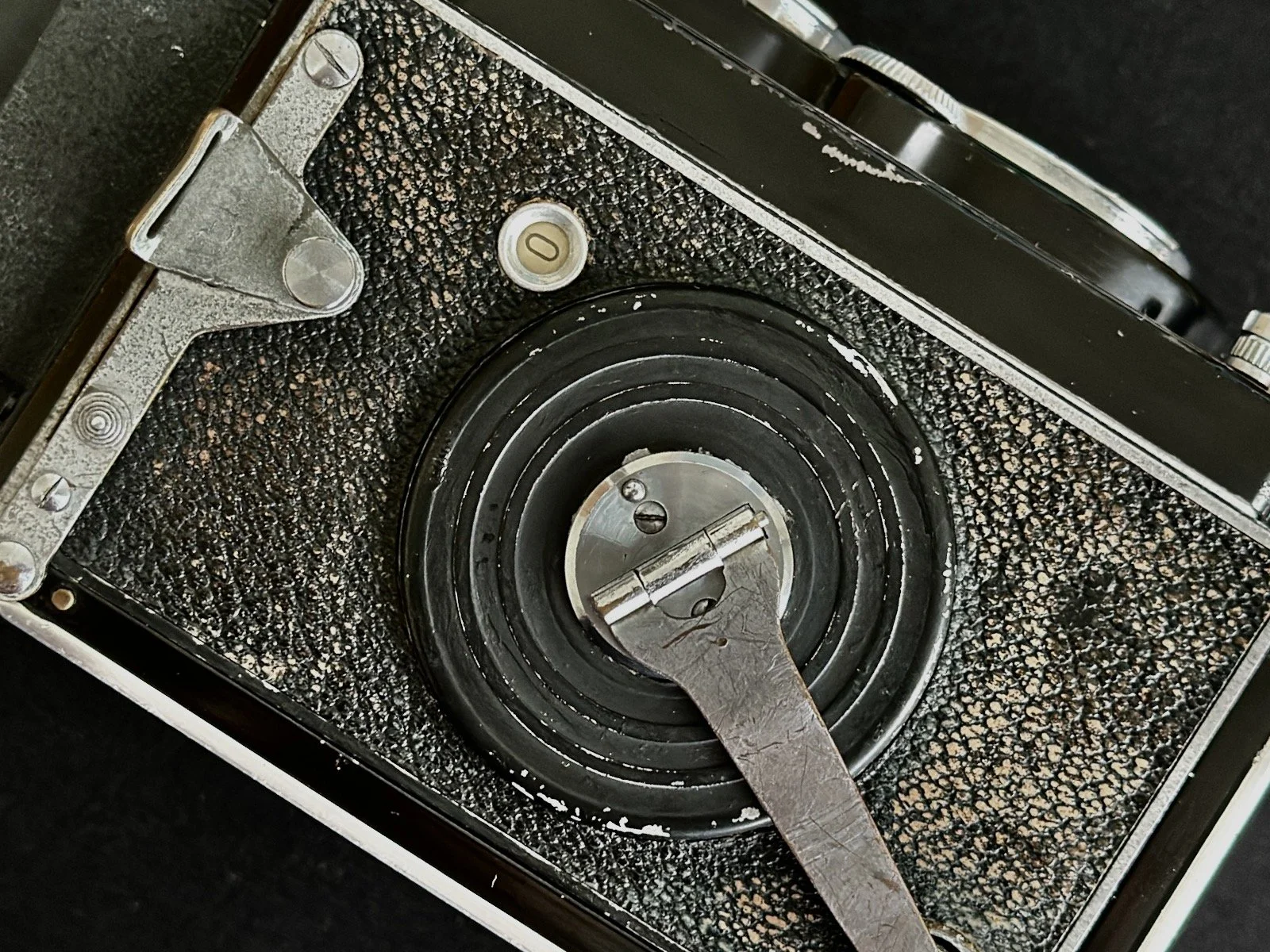FUN WITH FILM – 1950 ROLLEIFLEX AUTOMAT K4/50
12th November 2025
My Rolleiflex TLR,
75 years young.
I acquired my 1950 Rolleiflex Automat K4/50 medium format twin lens reflex camera from the legendary Len Lyons at R. G. Lewis, the much-missed Leica dealer in Holborn, London.
The Rolleiflex was sitting forlornly in Len’s bargain bucket sometime in the mid-1990s, most likely 1995 when I often visited R. G. Lewis to promote the Contax G1 camera system.
Already 45 years old, the Rolleiflex Automat had clearly lived a life but I decided to rescue it. I can’t even remember how little I paid for it, cameras like this were just not sought after in those days.
I only ever put a few rolls of film through the Rolleiflex, never being happy with the results. It was fairly sharp on the right hand side but very soft on the left, so about 25 years ago when the shutter jammed, the Rolleiflex just got put away in the loft and forgotten about.
Recently, while rummaging through boxes for some old lenses, I found the Rolleiflex and sent it off to the ‘Rollei Guru’ Keith Leedham. Keith still carries out a few service and repair jobs on these excellent cameras and for the princely sum of £75 he repaired the jammed shutter and winding mechanism as well as cleaning the hazy viewing and taking lenses. Keith also shimmed and realigned the lens platform, the cause of the focus issues.
The first film I put through the camera after the repair was disappointing but I think this was more down to the combination of a very dull day, Rollei Retro 400S film and the Rodinal developer, the images were lacking in contrast and very grainy. I then tried a roll of Kodak Ektar 100 film on a sunny day and was astounded by the sharpness, contrast and colours, a subsequent roll of Ilford HP5+ 400 had me hooked.
The Rolleiflex twin lens reflex camera (TLR) features a separate viewing and taking lens.
My camera has a 75mm Zeiss-Opton Tessar T single coated f/3.5 taking lens from the ‘real’ Carl Zeiss factory at Oberkochen rather than from Jena. The Compur–Rapid leaf shutter is mounted in the lens, as are the 10 aperture blades, and has speeds from 1 second – 1/500 second plus bulb exposure.
The upper viewfinder lens (a Heidoscop Anastigmat 75mm f/2.8) projects a reversed image via the fixed reflex mirror on to the ground glass viewing screen housed in the folding waist-level finder. It can be used to ‘shoot from the hip’ or raised to the eye like an SLR when the built in magnifier is folded out. 120 roll film is used giving 12off 56mm square photographs per film, this is ‘proper’ medium format with an image area around 3 times larger than 35mm film (36mm x 24mm) or a full-frame digital camera, therefore massive crops to virtually any shape or size are possible.
Modern digital ‘medium format’ cameras like the FujiFilm GFX 100 series and the Hasselblad X2D II 100C ‘only’ feature the Sony 43.8mm x 32.9mm CMOS sensor and even the £42,540 Phase One 150MP digital back (54mm x 40.5mm) still falls short of the vast image area of 120 medium format film.
Now 75 years old, my Rolleiflex K4/50 still produces images of superb quality.
Composition can be a challenge with the reversed image on the ground glass screen but overall it provides a thoroughly enjoyable, immersive shooting experience.
It will never be a museum piece but the ‘patina’ means I don’t have to worry too much when taking it out, consequently it is the film camera I use the most today.
Here is a small selection of images from my Rolleiflex Automat K4/50 (click on the thumbnails for larger images);
Rolleiflex K4/50, Ilford HP5+ 400 film
Rolleiflex K4/50 Automat, Kodak Ektar 100 film
Rolleiflex K4/50, Ilford HP5+ 400 film
Rolleiflex K4/50 Automat, Kodak Ektar 100 film
Rolleiflex K4/50, Ilford HP5+ 400 film
Rolleiflex K4/50, Ilford HP5+ 400 film
Rolleiflex K4/50 Automat, Kodak Ektar 100 film
Rolleiflex K4/50, Ilford HP5+ 400 film
Rolleiflex Automat K4/50 & Minolta Auto Meter III












